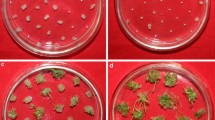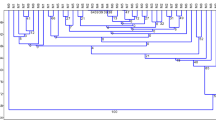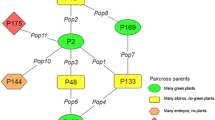Summary
Plant regeneration from cultured tissues has been shown to be under genetic control in a number of plant species. Using quantitative trait loci (QTL) mapping technology, it has become possible to estimate the number of loci controlling genetic variation and to characterize their map position in the genome. With the use of different types of mapping populations such as recombinant inbred lines (RIL), F2 or doubled haploids (DH) it was possible to detect QTLs for tissue culture response (TCR). For the evaluation of TCR numerous parameters describing induction and regeneration steps were applied. However, the lack of consistency with respect to parameters used by different researchers sometimes makes comparisons between QTL studies complicated. Another problem frequently present in works dealing with QTLs for TCR is skewed distributions of the traits used for evaluating tissue culture capability, usually interpreted as the indication of a presence of major genes. The majority of QTL analyses of TCR-traits were conducted with monocots – rice, barley and maize. The number of QTLs detected for a particular characteristic of tissue culture capability ranged from 1 to 8. The percentage of phenotypic variation explained by a single QTL varied from 2.7 to 65.4%, with the values between ca. 6 and ca. 26 % being more common. Determination of molecular markers linked to a QTL of TCR provides valuable tools for biotechnological approaches aimed at improving plant regeneration capability.
Similar content being viewed by others
Abbreviations
- CG:
-
callus growth
- DH:
-
doubled haploid
- DSC:
-
differential subtraction chain
- ELS:
-
embryo-like structures
- GDDSC:
-
genetically directed differential subtraction chain
- NRS:
-
number of regenerated shoots per callus
- RIL:
-
recombinant inbred line
- RR:
-
regeneration rate
- SD:
-
shoot differentiation
- SSD:
-
single seed descent
- TCR:
-
tissue culture response
- QTL:
-
quantitative trait loci
References
Andersen, S.B., I.K. Due & A. Olesen, 1987. The response of anther culture in a genetically wide material of winter wheat (Triticum aestivum L.). Plant Breed 99: 181–186.
Armstrong, C.L., J. Romero-Severson & T.K. Hodges, 1992. Improved tissue culture response of an elite maize inbred through backcross breeding and identification of chromosomal regions important for regeneration by RFLP analysis. Theor Appl Genet 84: 755–762.
Austin, D.F. & M. Lee, 1996. Comparative mapping in F2:3 and F6:7 generations of quantitative trait loci for grain yield and yield components in maize. Theor Appl Genet 92: 817–826.
Barret, P., M. Brinkman, P. Dufour, A. Murigneux & M. Beckert, 2004. Identification of candidate genes for in vitro androgenesis induction in maize. Theor Appl Genet 109: 1660–1668.
Ben Amer, I.M., V. Korzun, A.J. Worland & A. Börner, 1997. Genetic mapping of QTL controlling tissue-culture response on chromosome 2B of wheat (Triticum aestivum L.) in relation to major genes and RFLP markers. Theor Appl Genet 94: 1047–1052.
Bolibok, H., A. Wielogórska, M. Rakoczy-Trojanowska & P. Masoj'c, 2002. Analysis of in vitro regeneration ability of parental lines of a winter rye (Secale cereale L.) mapping population. Proceedings of the Conference ‘Biotechnology in Poland’, 25–28 September 2002, Gdansk, Poland: 28.
Bregitzer, P. & R.D. Campbell, 2001. Genetic markers associated with green and albino plant regeneration from embryogenic barley callus. Crop Sci 41: 173–179.
Caranta, C., A. Palloix, V. Lefebvre & A.M. Daubeze, 1997. QTL for a component of partial resistance to cucumber mosaic virus in pepper: restriction of virus installation in host-cells. Theor Appl Genet 94: 431–438.
Cowen, N.M., C.D. Johnson, K. Armstrong, M. Miller, A. Woosley, S. Pescitelli, M. Skokut, S. Belmar & J.F. Petolino, 1992. Mapping genes conditioning in vitro androgenesis in maize using RFLP analysis. Theor Appl Genet 84: 720–724.
El Attari, H., P.M. Hayes, A. Rebai, G. Barrault, G. Dechamp-Guillaume & A. Sarrafi, 1998. Potential of doubled-haploid lines and localization of quantitative trait loci (QTL) for partial resistance to bacterial leaf streak (Xanthomonas campestris pv. hordei) in barley. Theor Appl Genet 96: 95–100.
Flores Berrios, E., L. Gentzbittel, H. Kayyal, G. Alibert & A. Sarrafi, 2000. AFLP mapping of QTLs for in vitro organogenesis traits using recombinant inbred lines in sunflower (Helianthus annuus L.). Theor Appl Genet 101: 1299–1306.
Flores Berrios, E., A. Sarrafi, F. Fabre, G. Alibert & L. Gentzbittel, 2000. Genotypic variation and chromosomal location of QTLs for somatic embryogenesis revealed by epidermal layers culture of recombinant inbred lines in the sunflower (Helianthus annuus L.). Theor Appl Genet 101: 1307–1312.
Grosse, B.A., S. Deimling & H.H. Geiger, 1996. Mapping of genes for anther culture ability in rye by molecular markers. Vortr Pflanzenzeuchtg 35: 282–283.
Haley, C.S. & L. Andersson, 1997. Linkage mapping of quantitative trait loci in plants and animals. In: P.H. Dear, (Ed.) Genome Mapping A Practical Approach., pp. 49–71. Oxford University Press, Oxford.
Han, K.-H., H.D. Bradshaw, Jr. & M.P. Gordon, 1994. Adventitious root and shoot regeneration in vitro is under major gene control in an F2 family of hybrid poplar (Populus trichocarpa × P. deltoids). Forest Genet 1: 139–146.
He, P., L. Sheng, C. Lu, Y. Chen, & L. Zhu, 1998. Analysis of quantitative trait loci, which contribute to anther culturability in rice (Oryza sativa L.). Mol Breed 4: 165–172.
Henry, Y., P. Vain & J. De Buyser, 1994. Genetic analysis of in vitro plant tissue culture responses and regeneration capacities. Euphytica 79: 45–58.
Holme, I.B., A.M. Torp, L.N. Hansen, & S.B. Andersen, 2004. Quantitative trait loci affecting protoplast regeneration in Brassica oleracea. Theor App Genet 108: 1513–1520.
Knapp, S.J., W.C. Bridges Jr. & D. Birkes, 1990. Mapping quantitative trait loci using molecular marker linkage groups. Theor Appl Genet 79: 583–592.
Komatsuda, T., T. Annaka & S. Oka, 1993. Genetic mapping of a quantitative trait locus (QTL) that enhances the shoot differentiation rate in Hordeum vulgare L.. Theor Appl Genet 86: 713–720.
Komatsuda, T., F. Taguchi-Shiobara, S. Oka, F. Takaiwa, T. Annaka & H.-J. Jacobson, 1995. Transfer and mapping of the shoot differentiation locus Shd1 in barley chromosome 2. Genome 38: 1009–1014.
Koornneef, M., J. Bade, C. Hanhart, K. Horsman, J. Schel, W. Soppe, R. Verkerk & P. Zabel, 1993. Characterization and mapping of a gene controlling shoot regeneration in tomato.
Koornneef, M., C.J. Hanhart & L. Martinelli, 1987. A genetic analysis of cell culture traits in tomato. Theor Appl Genet 86: 633–341.
Kwon, Y.S., K.M. Kim, M.Y. Eun & J.K. Sohn, 2002. QTL mapping and associated marker selection for the efficacy of green plant regeneration in anther culture of rice. Plant Breed 12: 10–16.
Mahmood, T., U. Ekuere, F. Yeh, A.G. Good & G.R. Stringam, 2003. RFLP linkage analysis and mapping genes controlling the fatty acid profile of Brassica juncea using reciprocal DH populations. Theor Appl Genet 107: 283–290.
Manninen, O.M., 2000. Associations between anther-culture response and molecular markers on chromosomes 2H, 3H and 4H of barley (Hordeum vulgare L.). Theor Appl Genet 100: 57–62.
Mano, Y. & T. Komatsuda, 2002. Identification of QTLs controlling tissue-culture traits in barley (Hordeum vulgare L.). Theor Appl Genet 105: 708–715.
Mano, Y., H. Takahashi, K. Sato & K. Takeda, 1996. Mapping genes for callus growth and shoot regeneration in barley (Hordeum vulgare L). Breed Sci 46: 137–142.
Morgante, M. & F. Salamini, 2003. From plant genomics to breeding practice. Curr Opin Biotechnol 14: 214–219.
Murigneux, A., S. Bentollila, T. Hardy, S. Baud, C. Guitton, H. Jullien, S. Ben Tahar, G. Freyssinet & M. Beckert, 1994. Genotypic variation of quantitative trait loci controlling in vitro androgenesis in maize. Genome 37: 970–976.
Nadolska-Orczyk, A. & S. Malepszy, 1989. In vitro culture of Cucumis sativus L. 7. Genes controlling plant regeneration. Theor Appl Genet 78: 836–840.
Petolino, J.F. & A.M. Jones, 1986. Anther culture of elite germplasm of maize. Crop Sci 26: 1072–1074.
Popelka, J.C. & F. Altpeter, 2001. Interactions between genotypes and culture media components for improved in vitro response of rye (Secale cereale L.) inbred lines. Plant Cell Rep 20: 575–582.
Przybecki, Z., M.E. Kowalczyk, J. Witkowicz, M. Filipecki & E. Siedlecka, 2004. Polymorphom of sexually different cucumber (Cucumis sativus L.) NIL lines. Cel Mol Biol Lett 9: 919–933.
Rakoczy-Trojanowska, M. & S. Malepszy, 1993. Genetic factors influencing regeneration ability in rye (Secale cereale L.). I. Immature inflorescences. Theor Appl Genet 86: 406–410.
Rakoczy-Trojanowska, M. & S. Malepszy, 1995. Genetic factors influencing the regeneration ability of rye (Secale cereale L.). II. Immature embryos. Euphytica 83: 233–239.
Rakoczy-Trojanowska, M., M. Śmiech & S. Malepszy, 1997. The influence of genotype and medium on rye (Secale cereale L.) anther culture. Plant Cell Tissue Org Cult 48: 15–21.
Reddy, V.S., S. Leelavathi & S.K. Sen, 1985. Influence of genotype and culture medium on microspore callus induction and green plant regeneration in anthers Oryza sativa. Physiol Plant 63: 309–314.
Reish, B. & E.T. Bingham, 1980. The genetic control of bud formation from callus cultures of diploid alfalfa. Plant Sci Lett 20: 71–77.
Ribaut, J.-M. & D. Hoisington, 1998. Marker-assisted selection: new tools and strategies. Trends In Plant Sci 3: 236–239.
Schiantarelli, E., A. De la Peña & M. Candela, 2001. Use of recombinant inbred lines (RILs) to identify, locate and map major genes and quantitative trait loci involved with in vitro regeneration ability in Arabidopsis thaliana. Theor Appl Genet 102: 335–341.
Taguchi-Shiobara, F., 1999. Genetic analysis of regeneration ability of rice seed callus. Bull Natl Inst Agrobiol Resour 13: 97–134.
Taguchi-Shiobara, F., S.Y. Lin, K. Tanno, T. Komatsuda, M. Yano, T. Sasaki & S. Oka, 1997. Mapping quantitative trait loci associated with regeneration ability of seed callus in rice, Oryza sativa L. Theor Appl Genet 95: 828–833.
Takahashi, R., Y. Mano, K. Sato & K. Takeda, 1997. Mapping genes for callus growth and shoot regeneration in barley (Hordeum vulgare). II. Breed Sci 47: 116.
Takeuchi, Y., T. Abe & T. Sasahara, 2000. RFLP mapping of QTLs influencing shoot regeneration from mature seed-derived calli in rice. Crop Sci 40: 245–247.
Templeton-Sommers, K.M. & W.W. Collins, 1986. Heritability of regeneration in tissue cultures of sweet potato (Ipomoea batatas L.). Theor Appl Genet 71: 836–841.
Torp, A.M., A.L. Hansen & S.B. Andersen, 2001. Chromosomal regions associated with green plant regeneration in wheat (Triticum aestivum L.) anther culture. Euphytica 119: 377–387.
Van Deynze, A.E., J.C. Nelson, E.S. Yglesias, S.E. Harrington, D.P. Braga, S.R. McCouch & M.E. Sorrells, 1995. Comparative mapping in grasses. Wheat relationships. Mol Gen Genet 248: 744–754.
Wan, Y., T.R. Rocheford & J.M. Widholm, 1992. RFLP analysis to identify putative chromosomal regions involved in the anther culture response and callus formation of maize. Theor Appl Genet 85: 360–365.
Yamagishi, M., M. Otani, M. Higashi, Y. Fukuta, K. Fukui, M. Yano & T. Shimada, 1998. Chromosomal regions controlling anther culturability in rice (Oryza sativa L.). Euphytica 103: 227–234.
Yano, M. & T. Sasaki, 1997. Genetic and molecular dissection of quantitative traits in rice. Plant Mol Biol 35: 145–153.
Author information
Authors and Affiliations
Corresponding author
Rights and permissions
About this article
Cite this article
Bolibok, H., Rakoczy-Trojanowska, M. Genetic Mapping of QTLs for Tissue-Culture Response in Plants. Euphytica 149, 73–83 (2006). https://doi.org/10.1007/s10681-005-9055-6
Received:
Accepted:
Published:
Issue Date:
DOI: https://doi.org/10.1007/s10681-005-9055-6




